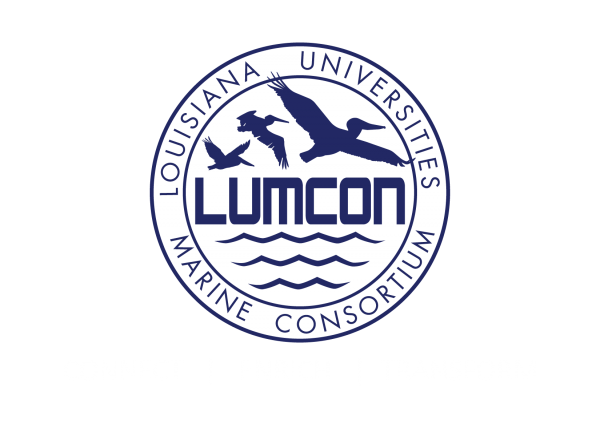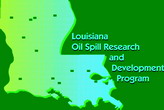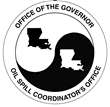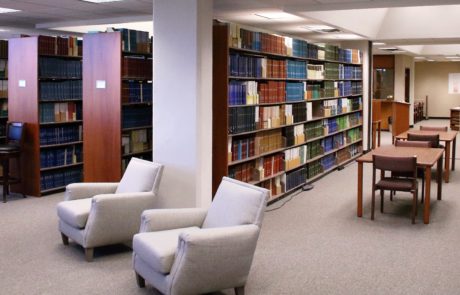LIBRARY
MAIN CATALOG (Electronic Resources/LUMCON Library)
Click here to search the Dispersants Bibliography
Click here to search Effects of Offshore Oil and Gas Development Bibliography
ABOUT THE LIBRARY
The LUMCON Library collection was originally housed in Ellender Memorial Library, located at Nicholls State University in Thibodaux, Louisiana. After completion of the DeFelice Marine Center in 1986, the collection was moved to its present location. Since that time, the Library has become an active resource center for LUMCON faculty and staff as well as Consortium member institutions, visiting researchers, students, and the public.
The library contains a computer lab and several study spaces available to visiting students, scientists, or groups (such as attendees of a writing retreat).
The collection and development of library materials reflects LUMCON’s research programs. The collection has approximately:
- 4,600 monographs
- 5,800 bound volumes
- 200 journal titles
- 26 current journal subscriptions
- 850 maps
- 35 atlases
- 3,600 government documents
- 1,500 reprints
In addition, the library houses a complete collection of research products generated by DeFelice Marine Center personnel since LUMCON’s inception.
HOURS OF OPERATION
- The LUMCON Library is staffed Monday through Friday from 7:00 AM to 3:30 PM. All visitors are welcome during these hours.
- The Library is closed to the public on weekends, state holidays, and when the librarian is not on site. Before visiting the facility, please call 985-851-2875 to ensure the Library will be open.
- All LUMCON staff, summer students, and resident visitors have 24-hour access to the Library. If the doors to the Library are locked, the security guard will open them for you.
CIRCULATION
- Books can be checked out by filling out a card at the circulation desk. The length of time a book can be checked out varies depending on the patron’s status. Books may be renewed by contacting the department, but all items are subject to recall at any time.
- Interlibrary loan service is available for LUMCON faculty, postdocs, lab personnel, and summer students. Although we strive to get items at no charge, the patron may be asked to pay for interlibrary loan charges under certain circumstances.
- Reserve items, reference materials, and journals must remain in the Library. The Library has no photocopier, but copies or scans can be made in the LUMCON main office.
- All materials must be checked out before removal from the Library, without exception.
- Library materials can be placed on reserve for summer classes. A list of items to be placed on reserve should be provided to the librarian as soon as possible.
- When returning material that has been checked out, please drop off items at the circulation counter.
Food is not allowed in the Library under any circumstance. Drinks are only allowed with prior approval by the librarian or the security guard.
INTERNSHIP PROGRAM
The LUMCON Library is available as an internship site for graduate-level students who have completed at least two semesters toward a Master’s degree in Library and Information Science. Applications will be accepted on a continuing basis and internships may be completed during any semester. Prior library experience or an undergraduate degree in science is desirable, but not necessary. Credits will be awarded based on the number of person-hours completed (40 person-hours per credit hour).
The internship will consist of both field experience, encompassing many operations of a special library, and a special project in technical services. The Librarian will give the intern an overview of reference services, technical services, library administration, and budgeting, and will guide the intern through special projects. The LUMCON Library uses SIRSI/Dynix’s Symphony Integrated Library System as well as OCLC for Cataloging/Interlibrary Loan services.
Contact the Librarian for more information or to apply for an internship.
ACKNOWLEDGMENTS
We would like to thank the following individuals for their guidance and input when creating the Dispersants Bibliography:
-
- Victoria Broje, Per Daling, Alun Lewis, and Francois-Xavier Merlin offered valuable assistance in the early phases of this project. Per Daling’s support was especially noteworthy, by providing conference proceedings that otherwise could not be obtained.
- Deborah Ansell, ITOPF’s librarian, contributed by sharing her sizeable list of library holdings on dispersant publications with us, and filling in gaps where existing citation information was incomplete.
- Likewise, Julie Anne Richardson, librarian for Environment Canada, compiled a publication listing on dispersants housed in her collection, which provided us with additional citations for our project.
- Qianxin Lin at Louisiana State University provided API conference proceedings for us to use in transcribing abstracts.
- Nancy Kinner at the Coastal Response Research Center provided encouragement, focus, and connected us with some of the aforementioned people.
- Finally, Don Davis and Karen Reeder Emory at OSRADP deserve special mention for all of their help and direction during the span of this project.
 |
 |
 |
The LUMCON Library is a member of the International Association of Aquatic and Marine Science Libraries and Information Centers (IAMSLIC), the Southeast Affiliate of IAMSLIC Libraries (SAIL), and the Louisiana Library Network and Information Consortium (LOUIS). Additionally, the Library has access to OCLC Cataloging/Interlibrary loan services.
Click here to search LUMCON’s e-Library catalog using the LOUIS portal.
DISPERSANTS BIBLIOGRAPHY
Cod, flounder, plaice, as well as other demersal and pelagic fish species, were used at various developmental stages (mostly egg and larval) to determine the toxicity of a number of hydrocarbons and oil-related products. Between 1 and 10 ppm of dispersant concentrates caused large proportions of abnormal embryos. Dispersant/oil combinations were also found to be toxic. Corexit 9527, Finasol OSR5 and Finasol OSR7 were found to be the most toxic of dispersants tested
Three medium-scale field experiments on the effects of oil, a dispersant and an oil/dispersant mixture were carried out in an intertidal mud flat ecosystem of the Wadden Sea (German Bight). For six successive tides each contaminant was added to the water enclosed in a mesocosm during submersion of the flat. The fate of the oil in the sediment and effects on phytobenthos, bacteria and macrozoobenthos were studied. Penetration of the oil into the sediment was mainly observed at the surface layer. were present when oil was chemically dispersed. Sublethal effects were found in some macrofauna species (reduced feeding activity) and in phytobenthic organisms (increased activity); oil degrading bacteria increased. No major effects were observed when the dispersant alone was added
Experiments with chemically and ultrasonically dispersed Arabian light crude oil and a dispersant (Finasol OSR 5) were carried out on an intertidal sand flat in the Wadden Sea (German Bight). “Bremerhaven Caissons,” flow through mescocosms for intertidal field experiments, allowed pollutant addition to the enclosed water during submersion time. Reiterated contaminations over a period of 12 successive tides of low concentrations of oil (10 ppm) and dispersant made it possible to study penetration and alteration processes of the dispersed oil in the sediment. Sublethal and lethal effects upon microphytobenthos, meiofauna, and macrofauna were observed. Oil reduced the activity of microbenthic algae and the food uptake of filter feeding bivalves and a polychaete. Nematodes showed a lower diversity and decreasing abundance in some groups. No major differences between the effects of chemically and ultrasonically dispersed oil on the benthos were observed. Application of dispersant alone had no clear effects when compared to controls
Gas chromatography with flame ionization detection was employed to determine the effectiveness of Corexit 9500 on various crude oils. Effectiveness was found to decrease with increasing weathering, but did not correlate with simple oil properties, such as density, viscosity, or maximum weathering percentages
A reevaluation of the analytical procedure used for the Swirling Flask Test found that the integration method could be improved. It is believed that integrating the entire chromatogram, rather than its peaks, would lead to a decrease in the maximum variation from 5% to 2%. Authors also recommended a consideration of using a vessel with a septum port instead of a spout. Results of tests using a septum flask found effectiveness results were approximately 8% lower, and showed lower standard deviations than the standard flask
Among the topics covered in this review are testing methodologies and procedures, environmental and physical variables, and analytical measurements and standards
This review compiles the findings of studies related to testing methodologies in effectiveness studies of dispersants done in large tanks. Critical factors warranting consideration included in methodology include mass balance, analytical method, measurements related to physical properties of the oil, and properties of the water in the tank, among other things
The authors review field monitoring protocols related to dispersant effectiveness. Current protocols, including NOAA’s Special Monitoring Applied Response Technology (SMART), are subject to false positives and false negative associated with the techniques. Twenty-eight considerations related to dispersant monitoring are listed, and recommendations are given for screening tests of dispersants to be undertaken before application of the dispersant in field tests
A review of published literature on oil spill countermeasures was initiated to find any data related to performance of countermeasure techniques in varying weather conditions. Results found that wind and wave height were the most important factors influencing countermeasures. The application and effectiveness of dispersants were found to be affected by weather because of the amount of dispersant that is applied directly to a spill is wind-dependent, and because the dispersal of oil and the amount of oil suspended in the water column are both dependent on turbulence of the ocean
Recent results of dispersant testing are reviewed, including slight revision in the dispersant analytical procedures, testing of new products, testing of long-term stored dispersants, and a comparison of Corexit 9527 and 9500 dispersant formulations. The procedure for the Swirling Flask Test has not altered appreciably since its inception, however the analysis of the quantity of oil dispersed has undergone significant changes. The originally-developed procedure made use of colorimetric analysis, but has since advanced to gas chromatographic analysis. With the change in analysis method, however, a host of subtle changes have been required that were not considered when first changing from colorimetry to gas chromatography. A number of minor improvements have been made to the procedure to correct and upgrade facets of the analysis. Several new dispersant products have been tested, results of this testing will be summarized. A test series was conducted on the dispersant Corexit 9527 that had been stored for more than 20 years in a tank truck. The tests show that the effectiveness, toxicity and colour of the product did vary somewhat between the three levels, however this might not be significant in terms of field effectiveness. A comparison of the laboratory effectiveness of Corexit 9527 and 9500 was completed. Results show that the effectiveness of 9500 is generally greater than that of 9527, however, this is not related to the amount of effectiveness. Generally, the higher the effectiveness, the greater the effectiveness of 9500 and vice versa. Statistically, about ¼ of the time, 9527 is more effective than 9500
Data are provided on 106 separate offshore experimental spills to determine dispersant field effectiveness. Effectiveness ratings for 25 of these spills were assigned by the experimenters; they vary from 0 to 100% and have an average of 33%. Measurement techniques used for these experiments are reviewed and describe. The techniques include: subsurface measurements to determine oil in the water column, surface sampling to determine oil remaining, dispersant application amount or distribution, and the use of remote sensing to observe visually the results or to quantify the area of surface oil. Existing means of detection and quantification appear to be effective. Most experimenters have used subsurface oil data in an attempt to establish a mass balance and thereby an effectiveness value. This technique is critically examined using values from historical trials, and it is shown that the subsurface oil does not have a regular distribution in relation to the surface slick. Correlation cannot be established between concentrations at depth or with time and distance. This lack of correlation implies that mass balance values based on subsurface oil concentrations in relation to the surface slick are not reliable. Effectiveness results claimed in the literature are also suspect because they do not correlate well with the maximum oil concentration seen at a given depth. The mathematical relationships used to provide the integrated amount of oil in the water column are also examined. It is shown by simulation that effectiveness claimed is highly sensitive to both assumptions and mathematical treatment. Historical data are used to show that effectiveness values can vary over an order of magnitude depending on the algorithm used. Values in the literature are generally the highest one would obtain using reasonable algorithms. A number of phenomena have been observed at spill sites. Herding of oil occurs immediately after dispersant application and has sometimes been misinterpreted as dispersion. Examinations of spills where slicks were monitored for longer than 3 h show that extensive resurfacing of oil occurred. Resurfacing is particularly problematic because, depending on current and wind, resurfacing may occur outside slick boundaries. When this occurs, resurfaced oil is not included in subsequent calculations, and consequently, effectiveness is overestimated. Field effectiveness cannot be reliably determined by using only measurements of oil in the water column. The distribution of oil in the water column is not known nor does it necessarily bear a relationship to surface slick boundaries. Furthermore, in the initial hours--perhaps as many as 7--the oil concentration in the water column may be transitory as significant amounts of oil resurface. Remote sensing over a long-term such as two or three days is suggested as the primary technique for monitoring experimental spills and for attempting to establish a mass balance
A large number of chemical agents for treating oil spills have been promoted in the past 20 years. During the seventeen years of the life of the Environmental Emergencies Technology Division over 100 dispersants have been tested for toxicity and/or effectiveness. Only eight products still remain on the accepted list and only about 15 products are still being produced. The compendium on oil spill treating agents prepared for the American Petroleum Institute in 1972 lists 69 dispersants and 43 beach cleanup agents, most of which are also dispersants. Only two of these are current commercial products, but both are produced in different formulations. Over 50 biodegradation agents, including bacterial mixtures, enzymes, or fertilizers have been proposed and only five of these, all very recent inventions, remain on the market
Laboratory effectiveness tests are described for four classes of spill-treating agents, solidifiers, demulsifying agents, surface-washing agents and dispersants. Many treating agents in these four categories have been tested for effectiveness and the results are presented here. Solidifiers or gelling agents solidify oil, requiring a large amount of agent to solidify oil-ranging between 16% by weight, to over 200%. Emulsion breakers prevent or reverse the formation of water-in-oil emulsions. A newly-developed effectiveness test shows that only one product is highly effective; however, many products will work, but require large amounts of spill-treating agent. Surfactant-containing materials are of two types, surface-washing agents and dispersants. Testing has shown that an agent that is a good dispersant is conversely a poor surface-washing agent, and vice versa. Tests of surface-washing agents show that only a few agents have effectiveness of 25-40%, where this effectiveness is the percentage of heavy oil removed from a test surface. Results using the 'swirling flask ' test for dispersant effectiveness are reported. Heavy oils show effectiveness values of about 1%, medium crudes of about 10%, light crude oils of about 30% and very light oils of about 90%
Laboratory studies on dispersant effectiveness have been conducted to assess the effect of several variables and to determine the action mechanisms of dispersants. The variables examined were temperature, salinity, and dispersant quantity. Dispersant effectiveness was measured and correlated with the five oil bulk components, asphaltenes, aromatics, polar compounds, saturate compounds and waxes. The effect of water temperature variation is logarithmically correlated to dispersant effectiveness. The effect of salinity on typical commercial dispersant formulations is that effectiveness is at a peak when salinity is about 40 ‰ (parts per thousand) and falls to nearly zero as salinity decreases to 0. Effectiveness also falls to 0 as salinity rises from 40 to 80 parts per thousand. This behavior is explained by the necessity for a certain level of ionic strength to stabilize the surfactant between the oil droplet and the water. Dispersant quantity is found to be an important factor. Dispersant-to-oil ratios greater than 1:40 to 1:60 result in very low dispersant effectiveness. Effectiveness is logarithmic with respect to dispersant-to-oil ratio. Dispersion experiments were conducted to investigate the effect of oil composition. Dispersant effectiveness is positively and strongly correlated with the saturate concentration in the oil and is negatively correlated with aromatic, asphaltene and polar compound contents of the oil. Dispersant effectiveness is only weakly correlated with oil viscosity. Dispersant effectiveness is primarily limited to oil composition
Laboratory effectiveness tests have been developed for four classes of spill treating agents: solidifiers, demulsifying agents, surface-washing agents, and dispersants. Many of the currently available treating agents in these four categories have been tested for effectiveness. These results are presented. Solidifiers or gelling agents change liquid oil to a solid. Tests show that these require a large amount of agent to solidify oil, ranging from 16 percent by weight to over 200 percent. Demoussifiers or emulsion breakers are used to prevent or reverse the formation of water-in-oil emulsions. A newly developed effectiveness test shows that only one product is highly effective. However, many products will work, but require large amount of spill treating agent. Surfactant-containing materials are of two types, surface-washing agents and dispersants. Testing has shown that an agent that is a good dispersant is conversely a poor surface-washing agent, and vice versa. Tests of surface washing agents show that only a few agents have effectiveness of 25 to 40 percent, where this effectiveness if defined as the percentage of oil removed from a test surface. Extensive work has been done on dispersant testing and comparison of laboratory tests. All laboratory tests will yield the same effectiveness value if the oil-to-water ratio is about 1:1,000 or greater, and if a settling time of 10 or more minutes is employed. Extensive results using the “swirling flask” test are reported. Heavy oils show effectiveness values of about 1 percent, medium crude of about 10 percent, light crude oils of about 30 percent, and very light oils of about 90 percent
Laboratory effectiveness test results are presented for four classes of spill-treating agents: solidifiers, demulsifying agents, surface-washing agents and dispersants. Solidifiers or gelling agents required large amounts of agents to solidify oil - ranging by weight from 16% to over 200%. For demulsifiers, an effectiveness test showed that only one product was highly effective, although many products would work, but required large amounts of spill-treating agent. Surfactant-containing materials were comprised of two types, surface-washing agents and dispersants. Testing showed that an agent that was a good dispersant was a poor surface-washing agent, and vice versa. Tests of surface-washing agents showed that only a few agents had effectiveness of 25 to 40%, with effectiveness expressed as the percentage of oil removed from a test surface. The 'swirling flask' test for dispersant effectiveness was used. Heavy oils showed effectiveness values of about 1%, medium crudes of about 10%, light crude oils of about 30% and very light oils of about 90%
A study of the relationship of dispersant effectiveness and mixing energy was performed. Energy was varied by changing the rotational speed of a specially designed apparatus. The effects of dispersant type and oil type were also measured. The stability of the resulting emulsions was gauged by measuring the amount of oil that remained in the water column over time. The findings are that each oil-dispersant combination shows a unique threshold or onset of dispersion. The effectiveness goes up linearly with energy, expressed as flask rotational speed. Natural dispersion was also measured and shows behavior similar to that of chemical dispersion, except that the thresholds occur at a higher energy and effectiveness rises more slowly with increasing energy. Effectiveness (defined as the percentage of oil in the water column) rises rapidly to 80 to 90 percent with increasing energy for light oils treated with chemical dispersants. Heavier oils will disperse, but to lesser effectiveness values
This database consists of citations found in journals, conference proceedings, government reports and gray literature covering over 40 years of published research on oil spill dispersants. Citations were collected from 1960 through June 2008. This bibliography was compiled and edited by John Conover, Associate Librarian at LUMCON, and funded by a grant from the Louisiana Applied and Educational Oil Spill Research and Development Program (OSRADP).
EFFECTS OF OFFSHORE OIL AND GAS DEVELOPMENT BIBLIOGRAPHY
|
Quarterly Issues
|
Compilations
|
- Biology
- Ecological, anatomical, and physiological effects of oil and/or gas, Species as biomarkers, PAH uptake and bioaccumulation, etc.
- Chemistry/Geochemistry/Geology
- Biochemistry, Biodegradation, Bioremediation, Hydrocarbon degradation, Environmental sampling, Soil contamination, etc.
- Engineering/Physics
- Technological advancements in facility/equipment design and use, Spill response and recovery equipment, Physical properties of oil and gas, etc.
- Environment/Ecosystem Management/Spills
- Environmental assessment and management, Oil and/or gas spill description and analysis, etc.
- Socioeconomic/Regulation/General
- Social and economic ramifications, Politics, Governmental policy and legislation, Organizational policy, General interest, etc.
This bibliography is a quarterly compilation of current publications (citations with abstracts) from a wide variety of electronic and print information sources relating to offshore oil and gas development. It is compiled and edited by John Conover, Associate Librarian at LUMCON. Items listed may or may not be available at the LUMCON Library. Items without annotations were unavailable for perusal prior to publication.
All questions about using library facilities, locating library resources, or searching LUMCON catalogs should be directed to the Librarian.


